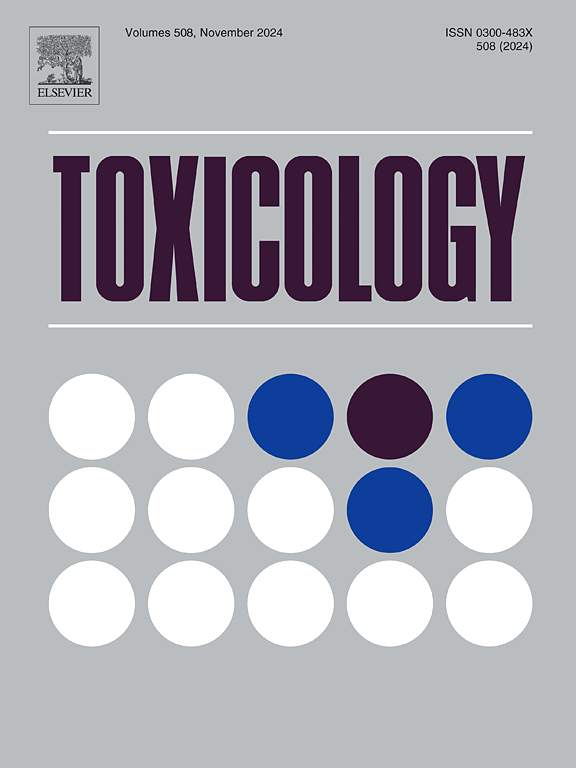聚苯乙烯微塑料通过TLR4/NF-κB/COX-2通路和肠道菌群调节引发大鼠结肠炎症
IF 4.8
3区 医学
Q1 PHARMACOLOGY & PHARMACY
引用次数: 0
摘要
聚苯乙烯微塑料(PS-MPs)是一种常见的微塑料,对人类健康造成重大危害。由于肠道系统具有多功能性,mp相关损伤及其机制有待进一步探索。本研究旨在阐明PS-MP暴露对大鼠结肠炎症的影响,并探讨其潜在机制。48只无特定病原体的Wistar雄性大鼠分别给予0、0.5、5和50 mg/kg/d的PS-MPs,持续90 d,观察肠道菌群分布、结肠炎症因子水平和TLR4/NF-κB/COX-2基因水平。为了明确PS-MPs是否直接浸润肠上皮细胞并诱导细胞毒性,将人肠上皮细胞(HIECs)暴露于PS-MP浓度范围(0 ~ 100 μg/mL) 48 h,并进行CCK-8测定以评估细胞存活率。暴露于PS-MP的大鼠结肠组织中,杯状细胞减少,肌肉层排列紊乱,结肠组织出现中断不连续的隐窝结构,大量炎症细胞浸润结肠黏膜和粘膜下层。PS-MPs可在HIECs中积累,降低细胞存活率。暴露于PS-MPs的大鼠结肠中,白细胞介素(IL)-1β、IL-6和肿瘤坏死因子(TNF)-α水平升高。此外,ps - mp暴露大鼠结肠中TLR4/MyD88 mRNA和蛋白水平显著升高。此外,MP暴露后大鼠结肠TLR4/NF-κB/COX-2信号通路被激活。当TLR4/NF-κB/COX-2信号通路被抑制时,PS-MPs引起的IL-6和TNF-α水平的显著升高被显著逆转。PS-MP暴露也改变了大鼠肠道菌群的丰度。与对照组相比,PS-MPs暴露组中厚壁菌门、变形菌门和放线菌门的比例增加。拟杆菌门和Verrucomicrobia的比例则有所下降。综上所述,我们的研究结果表明,PS-MP可能对大鼠的胃肠道健康产生不利影响。促炎细胞因子(IL-6、IL-1β、TNF-α)水平升高,触发TLR4/NF-κB/COX-2信号通路。因此,菌群的变化和肠道炎症的增加可能相互作用。本文章由计算机程序翻译,如有差异,请以英文原文为准。
Polystyrene microplastics trigger colonic inflammation in rats via the TLR4/NF-κB/COX-2 pathway and modulation of intestinal microbiota
Polystyrene microplastics (PS-MPs) are common microplastics that pose significant health hazards to humans. Due to multifunctionality in the gut system, MP-associated damage and mechanisms require further exploration. This study was undertaken with the objective of elucidating the impact of PS-MP exposure on colonic inflammation in rats, and to explore its potential mechanisms. Forty-eight specific-pathogen-free Wistar male rats were administered 0, 0.5, 5, and 50 mg/kg/d of PS-MPs for 90 days, after which intestinal flora distribution, inflammatory factor levels in the colon, and TLR4/NF-κB/COX-2 gene levels were examined. To clarify whether PS-MPs directly infiltrate intestinal epithelial cells and induce cytotoxicity, human intestinal epithelial cells (HIECs) were exposed to a range of PS-MP concentrations (0 ∼ 100 μg/mL) for 48 h, and CCK-8 assays were conducted to assess the cell survival rates. In the colon tissue of rats exposed to PS-MP, goblet cells decreased, muscular layer arrangements were disordered, and disrupted and discontinuous crypt structures appeared in colon tissue, while high numbers of inflammatory cells infiltrated the colonic mucosa and submucosa. PS-MPs could accumulate in HIECs, and cell survival rates were decreased. In the colons of rats exposed to PS-MPs, the levels of Interleukin (IL)-1β, IL-6, and tumor necrosis factor (TNF)-α were found to be elevated. Additionally, the mRNA and protein levels of TLR4/MyD88 in the colons of PS-MP-exposed rats exhibited a significant increase. Furthermore, the TLR4/NF-κB/COX-2 signaling pathway in rat colons was activated after MP exposure. When the TLR4/NF-κB/COX-2 signaling pathway was inhibited, the significant increases in IL-6 and TNF-α levels caused by PS-MPs were significantly reversed. PS-MP exposure also altered intestinal flora abundance in rats. Compared with the control group, the proportion of Firmicutes, Proteobacteria and Actinobacteria in PS-MPs exposed group was increased. In contrast, the proportion of Bacteroidetes and Verrucomicrobia decreased. Taken together, our results suggest that PS-MP could exert adverse effects on the gastrointestinal health of rats. Pro-inflammatory cytokine (IL-6, IL-1β and TNF-α) levels increased, and the TLR4/NF-κB/COX-2 signaling pathway was triggered. Thus, flora changes and increased intestinal inflammation may interact with each other.
求助全文
通过发布文献求助,成功后即可免费获取论文全文。
去求助
来源期刊

Toxicology
医学-毒理学
CiteScore
7.80
自引率
4.40%
发文量
222
审稿时长
23 days
期刊介绍:
Toxicology is an international, peer-reviewed journal that publishes only the highest quality original scientific research and critical reviews describing hypothesis-based investigations into mechanisms of toxicity associated with exposures to xenobiotic chemicals, particularly as it relates to human health. In this respect "mechanisms" is defined on both the macro (e.g. physiological, biological, kinetic, species, sex, etc.) and molecular (genomic, transcriptomic, metabolic, etc.) scale. Emphasis is placed on findings that identify novel hazards and that can be extrapolated to exposures and mechanisms that are relevant to estimating human risk. Toxicology also publishes brief communications, personal commentaries and opinion articles, as well as concise expert reviews on contemporary topics. All research and review articles published in Toxicology are subject to rigorous peer review. Authors are asked to contact the Editor-in-Chief prior to submitting review articles or commentaries for consideration for publication in Toxicology.
 求助内容:
求助内容: 应助结果提醒方式:
应助结果提醒方式:


